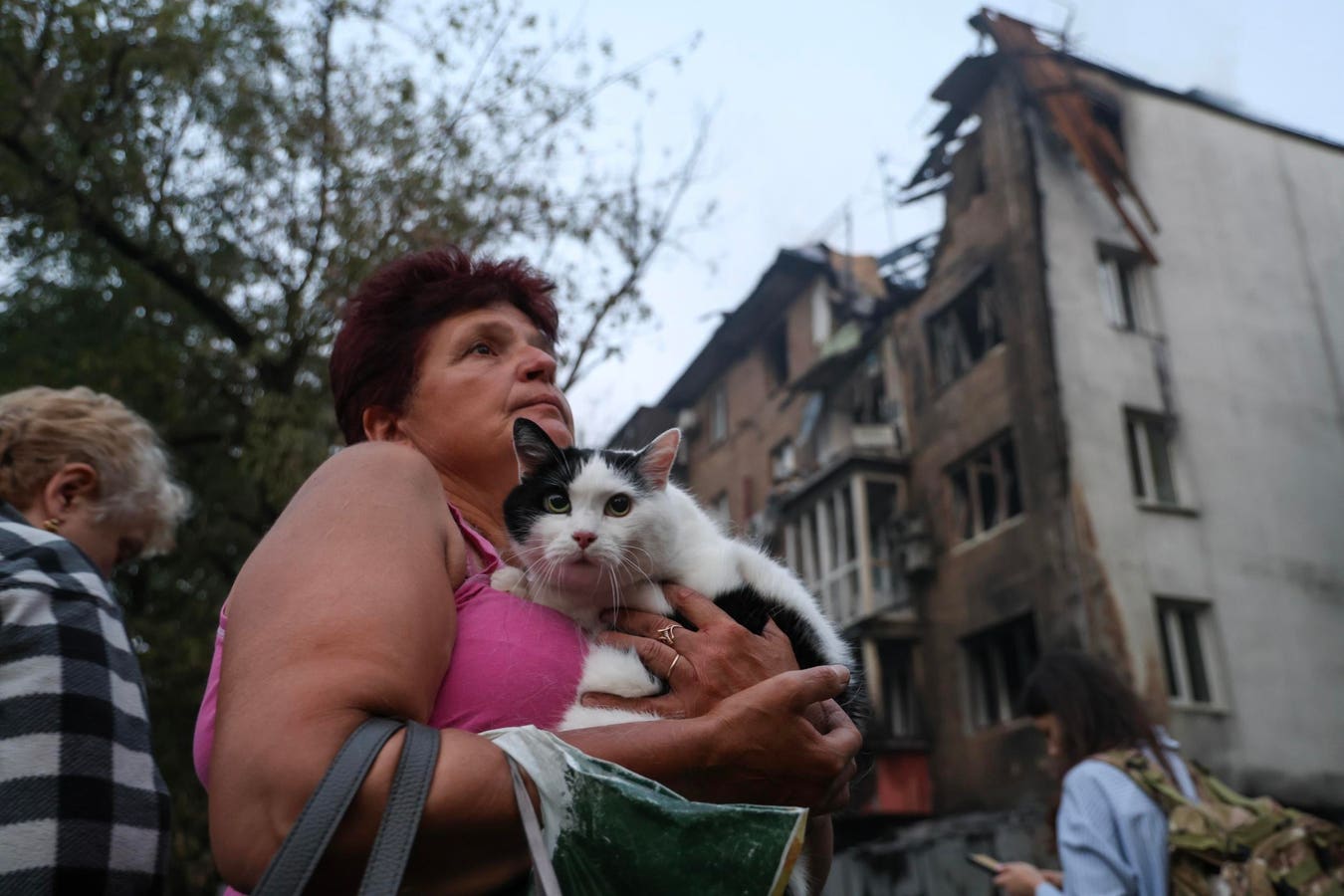KYIV, UKRAINE – JULY 10: A woman holds a cat in her arms standing in front of an apartment building … More
Dispatches from Ukraine. Day 1,234
Russian Attacks on Ukraine and War Developments
Russia hammered Ukraine with 1,125 drones and decoys and 31 missiles over two consecutive nights of strikes. July 9 saw the most intense Russian barrage of the war, with 728 drones dispatched, surpassing the previous single-attack record by about 200 units. Ukrainian forces intercepted 13 cruise missiles and eight ballistic missiles, while neutralizing 460 drones, as well as electronically jamming an additional 619 drones. Still, impacts were recorded in 12 locations, and none of the six Kinzhal hypersonic missiles were downed. The massive bombardment on July 9, primarily targeting the western city of Lutsk, caused no civilian casualties. By contrast, the attack that followed in the early hours of July 10, with drones seemingly descending on Ukraine’s capital, Kyiv, from all directions, killed two residents and wounded 26 others.
In addition to the back-to-back, mammoth overnight strikes, other Russian attacks killed at least 21 civilians across Ukraine on July 7-10. In eastern Donetsk oblast, or region, Russian artillery shelling and drone attacks resulted in 15 civilians deaths, with 31 others wounded. In northeastern Kharkiv oblast, Russian attacks killed two individuals and injured 46 others, while a Russian drone strike killed one resident in the central Dnipropetrovsk region. In southern Kherson oblast, the regional governor reported three residents killed and 35 others injured.
Following a string of Russian aerial strikes of record proportions, Ukrainian President Volodymyr Zelenskyy said on July 10 that he expects Russia to try to regularly launch mega drone strikes of 700–1,000 units per night against his country. Speaking at the International Ukraine Recovery Conference in Rome, Zelenskyy said that Kyiv has already found a key to neutralizing Russia’s drone warfare: cheap, domestically manufactured “interceptor drones.” He also stated that Ukraine is ready to mass-produce this type of drone but urgently needs more financing.
Ukraine’s problems are not limited to the skies. Russia is outpacing Ukrainian recruitment and is now advancing faster than at any point in two years. According to an independent Ukrainian open source intelligence project, Russia seized control of roughly 215 square miles of Ukrainian territory in June, the most since last November.
Russia’s current offensive on Ukrainian soil is shaping up to be its deadliest yet, with some 31,000 Russian troops killed since early May. Using NASA satellite data and casualty modeling, British weekly The Economist estimates total Russian losses between 900,000 and 1.3 million since the start of the invasion, including up to 350,000 dead; Ukrainian military deaths, in turn, are estimated between 73,000 to 140,000 troops.
U.S. Renews Military Aid to Ukraine
The U.S. has resumed military aid shipments to Ukraine, following a controversial pause earlier this month. The temporary halt, reportedly authorized by Defense Secretary Pete Hegseth on July 2 without notifying the White House or U.S. allies, sparked confusion in Ukraine and Europe. According to U.S. and Ukrainian officials, the weapons shipments had already reached as far as Poland when defense officials abruptly stopped them.
According to CNN, Trump ordered Hegseth to renew some Ukraine-bound supplies, such as critical Patriot missiles, shortly after learning about the suspension. On July 7, the Pentagon issued a statement confirming the renewal of support. “At President Trump’s direction, the Defense Department is sending additional defensive weapons to Ukraine to ensure the Ukrainians can defend themselves while we work to secure a lasting peace and ensure the killing stops.”
Trump has in recent weeks expressed a desire to bolster Ukraine’s defenses, particularly with Patriot systems, which he has previously called “very effective,100% effective.” He further expressed frustration with Russian President Vladimir Putin during a Cabinet meeting on July 8, saying that “He’s very nice all the time, but it turns out to be meaningless.”
International
The European Court of Human Rights sided with Ukraine and the Netherlands in the largest case involving nation state litigants hitherto brought before the court. The case, which spanned more than a decade and drew support from 26 countries, consolidated four separate complaints, including the downing of Malaysia Airlines Flight 17 over Russian-occupied Ukrainian territory in 2014, the deadliest plane crash of the 21st century after the Sept. 11 terrorist attacks in New York.
The ruling concluded that Russia was behind the downing of the Malaysia Airlines Boeing and found it responsible for the forced deportation of Ukrainian children to Russia, as well as the suppression of Ukrainian language and culture. The court affirmed that Moscow’s military presence in Ukraine was part of a strategy to exert control over Ukraine’s people and sovereignty. Kremlin spokesperson Dmitry Peskov dismissed the court’s judgments, stating that Russia “has no intention of enforcing them.”
The European Union is racing to plug a shortfall of as much as $19 billion in Ukraine’s 2026 annual budget. Among the options EU officials are weighing are speeding up loans from a $50 billion G7 program and turning military aid into off-budget grants that will count toward NATO’s new 5% (of GDP) defense spending target for member states. Brussels is also considering shifting frozen Russian assets into riskier, higher-yield investment vehicles to boost profits it can use to aid Ukraine, while diversifying potential losses away from Belgium, where most of the frozen Russian funds are concentrated.
Despite increasing financial support from European allies, Ukraine is facing a growing budget shortfall amid dwindling U.S. aid. On June 30, the Ukrainian government sent an updated budget plan for this year to its parliament, the Verkhovna Rada. The new plan increases total expenditures by about $10.7 billion, most of which will be allocated to weapons procurement.
By Danylo Nosov, Karina L. Tahiliani




